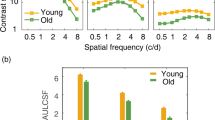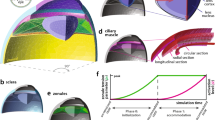Abstract
The decline in visual function observed in older adults has been attributed to a deterioration in optical quality, decreased neural function, or a combination of both of these factors. One way of separating their contribution is to design a simulation of the optics of the elderly eye and examine its effect on the visual performance of younger observers. The age-related reduction in pupil size was simulated by the administration of an ophthalmic miotic drug, whilst a neutral density filter was included to account for the increased absorption of the ocular media. An optical cell containing a critical concentration of 500 nm diameter polystyrene microspheres in suspension was used to simulate light scatter. The spatiotemporal contrast sensitivity of an older group of observers was then compared with that of a younger group with and without the optical simulation. The contrast sensitivity of the younger group was consistently better than that of the older, and the presence of the optical simulation produced no significant effect on performance. This suggests that, under normal viewing conditions, it is primarily neural factors which underlie the deterioration in visual quality experienced by older observers.
Similar content being viewed by others
References
Weale RA. The Aging Eye. London: HK Lewis and Co, 1963.
Wolf E, Gardiner JS. Studies on the scatter of light in the diotpric media of the eye as a basis of visual glare. Arch Ophthalmol 1965; 74: 338–345.
IJspeert JK, de Waard PWT, van den Berg TJTP, de Jong PTVM. The intraocular stray light function in 129 healthy volunteers: Dependence on angle, age and pigmentation. Vis Res 1990; 30: 699–707.
Ordy JM, Brizzee KR, Johnson HA. Cellular alterations in visual pathways and the limbic system: Implications for vision and short-term memory. In: Sekuler R, Kline D, Dismukes K (eds), Aging and Human Visual Function. New York: Liss, 1982: 79–114.
Devaney KO, Johnson HA. Neuron loss in the aging visual cortex of man. J Gerontol 1980; 35: 836–841.
Weale RA. Senile changes in visual acuity. Trans Ophthalmol Soc UK 1975: 95; 36–38.
Owsley C, Sekuler R, Siemsen D. Contrast sensitivity throughout adulthood. Vis Res 1983; 23: 689–699.
Sekuler R, Kline D, Dismukes K, Adams AJ. Some research needs in aging and visual perception. Vis Res 1983; 23: 213–216.
Morrison JD, McGrath C. Assessment of the optical contributions to the age-related deterioration in vision. Q J Exp Physiol 1985; 70: 249–269.
Elliott DB. Contrast sensitivity decline with aging: A neural or optical phenomenon? Ophthal Physiol Opt 1987; 7: 415–419.
Elliott DB, Whitaker D, Thompson P. Use of displacement threshold hyperacuity to isolate the neural component of senile vision loss. Appl Opt 1989; 28: 1914–1918.
Sturr JF, Church KL, Taub HA. Temporal summation functions for detection of sine-wave gratings in young and older adults. Vis Res 1988; 28: 1247–1253.
Elliott DB, Whitaker D, MacVeigh D. Neural contribution to spatiotemporal contrast sensitivity decline in healthy aging eyes. Vis Res 1990; 30: 541–547.
Sloane ME, Owsley C, Alvarez SL. Aging, senile miosis and spatial contrast sensitivity at low luminance. Vis Res 1988; 28: 1235–1246.
Pelli DG, Robson JG, Wilkins AJ. The design of a new letter chart for measuring contrast sensitivity. Clin Vis Sci 1988; 2: 187–199.
Higgins KE, Jaffe MJ, Caruso RC, DeMonasterio FM. Spatial contrast sensitivity: Effects of age, test-retest and psychophysical method. J Opt Soc Am 1988; A5: 2173–2180.
Bettelheim FA. Physical basis of lens transparency. In: Maisel H (ed), The Ocular Lens. New York: Marcel Dekker, 1985: 265–300.
Wood JM, Wild JM, Crews SJ. Induced intraocular light scatter and the sensitivity gradient of the normal visual field. Graefe's Arch Clin Exp Ophthalmol 1987; 225: 369–373.
Wetherill GB, Levitt H. Sequential estimation of points on a psychometric function. Br J Math Stat Psychol 1965; 18: 1–10.
Paulsson L-E, Sjöstrand J. Contrast sensitivity in the presence of a glare light. Invest Ophthalmol Vis Sci 1980; 19: 401–406.
van den Berg TJTP. On the relation between glare and straylight. Doc Ophthalmol 1991; 78: 177–181.
Derefeldt FD, Lennerstrand G, Lundh B. Age variations in normal human contrast sensitivity. Acta Ophthalmol 1979; 57: 679–690.
Owsley C, Gardner T, Sekuler R, Lieberman H. Role of the crystalline lens in the spatial vision loss of the elderly. Invest Ophthalmol Vis Sci 1985; 26: 1165–1170.
Sloane ME, Owsley C, Jackson CA. Aging and luminance adaptation effects on spatial contrast sensitivity. J Opt Soc Am 1988; A5: 2181–2190.
Tulunay-Keesey U, Ver Hoeve JN, Terkla-McGrane C. Threshold and suprathreshold spatiotemporal response throughout adulthood. J Opt Soc Am 1988; A5: 2191–2200.
Laming D. Contrast sensitivity. In: Cronly-Dillon JR (eded), Vision and visual dysfunction. London: MacMillan, 1991; 5: 35-43.
Weale RA. Real light scatter in the human crystalline lens. Graefe's Arch Clin Exp Ophthalmol 1986; 224: 463–466.
Vos JJ. Disability glare — A state of the art report. CIE-J 1984; 3: 39–53.
van den Berg TJTP, IJspeert JK, de Waard PWT. Dependence of intraocular straylight on pigmentation and light transmission through the ocular wall. Vis Res 1991; 31: 1361–1367.
Zuckerman JL, Miller D, Dyes W, Keller M. Degradation of vision through a simulated cataract. Invest Ophthalmol 1973; 12: 213–224.
Campbell FW, Green DG. Optical and retinal factors affecting visual resolution. J Physiol (Lond) 1965; 181: 576–593.
van Heyningen R. What happens to the human lens in cataract? Sci Am 1975; 233: 70–81.
Author information
Authors and Affiliations
Rights and permissions
About this article
Cite this article
Whitaker, D., Elliott, D.B. Simulating age-related optical changes in the human eye. Doc Ophthalmol 82, 307–316 (1992). https://doi.org/10.1007/BF00161018
Accepted:
Issue Date:
DOI: https://doi.org/10.1007/BF00161018




